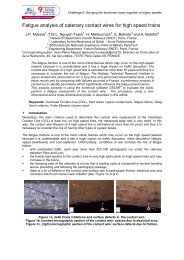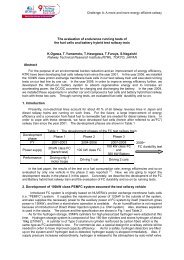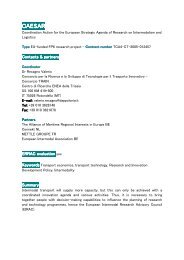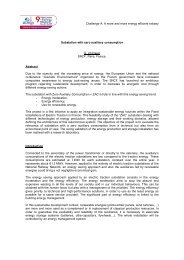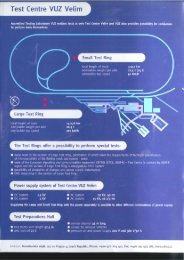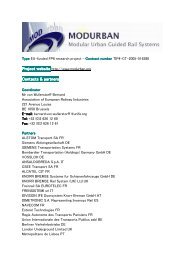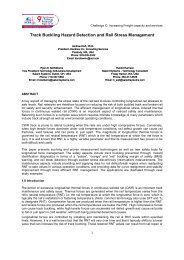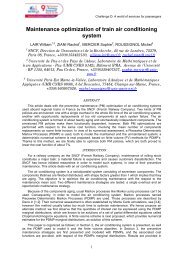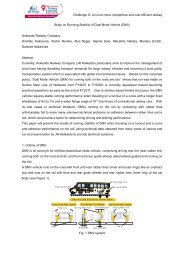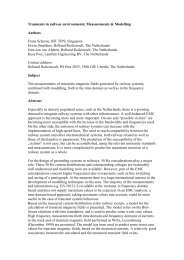Challenge B: An environmentely friendly railway Development of ...
Challenge B: An environmentely friendly railway Development of ...
Challenge B: An environmentely friendly railway Development of ...
You also want an ePaper? Increase the reach of your titles
YUMPU automatically turns print PDFs into web optimized ePapers that Google loves.
<strong>Challenge</strong> B: <strong>An</strong> <strong>environmentely</strong> <strong>friendly</strong> <strong>railway</strong><br />
<strong>Development</strong> <strong>of</strong> pantograph for the Series N700 Shinkansen<br />
Y.Nakakura 1 , K.Sakanoue 1 , Y.Minami 1 , Y.Okada 1<br />
1 Central Japan Railway Company, Tokyo, Japan<br />
Abstract<br />
“The Series N700” Shinkansen train was developed under the concept “Latest, fastest and best rolling<br />
stock for direct operation on the Tokaido and Sanyo Shinkansen.” The Series N700 takes form to<br />
evolve the high-performance Series 700 and increased the maximum operating speed from 285 km/h<br />
to 300 km/h. [1]. In the case <strong>of</strong> high-speed <strong>railway</strong>s, aerodynamic noise is dominant,since exterior<br />
noise level is increasing with proportional to the sixth power <strong>of</strong> speeds. Therefore, exterior noise is<br />
even more critical for the increase in speed.<br />
The pantograph for the Series N700 Shinkansentrainis a single-arm type pantograph which was<br />
developed to focus on noise reduction and adjustment to adequateaerodynamic uplift force on contact<br />
wire. Current-collection system noise is known to account for a large part <strong>of</strong><br />
exteriornoise.Theexcessive aerodynamic uplift forcecausesdamages or wears tocontact wire and the<br />
insufficientforcealso causes contact loss which decreases current-collection performance.Therefore, it<br />
is crucial to keep maintain adequateaerodynamic uplift force on contact wire.<br />
To reduce exterior noise, the knuckle <strong>of</strong> pantograph frame, which was the noise emitting source on the<br />
conventional single-arm type pantograph for the Series 300 and 700, was covered by entire wind<br />
protection cover with a streamline shape. However, depending on running directions, fluctuation <strong>of</strong><br />
aerodynamic uplift force swelled up because the shape <strong>of</strong> pantograph frame exposed to running wind<br />
changes from “
<strong>Challenge</strong> B: <strong>An</strong> <strong>environmentely</strong> <strong>friendly</strong> <strong>railway</strong><br />
alwayscompatible with noise reduction.The Series N700 pantograph as shown in Figure 1 achieved<br />
noise reduction, while keeping adequate current-collection and aerodynamic uplift force.<br />
This paper introducesa method <strong>of</strong> noise reduction,adjustment aerodynamic uplift force with respect to<br />
pantograph <strong>of</strong> the Series N700<br />
Fig.1: Overview <strong>of</strong> the Series N700 pantograph<br />
2.Preconditionsand Targets<strong>of</strong> development<br />
2.1Preconditions <strong>of</strong> development<br />
Preconditions <strong>of</strong> development are shown below.<br />
・Maximum speed in the Sanyo section : 300km/h (Tokaido section: 270km/h)<br />
・Height <strong>of</strong> ro<strong>of</strong><br />
: 3600mm (From rail level)<br />
・Height <strong>of</strong> rolling stock gauge<br />
: 4500mm (From rail level)<br />
・Height at "lower/upper operating position" : 4800~5300mm (From rail level)<br />
・Maximum collected current<br />
: 1000A<br />
・Performance mentioned above is not depend on train running direction<br />
・Adapted to body inclining system (air spring mechanism: 1”inclining) [2]<br />
2.2Targets <strong>of</strong> development<br />
Targets <strong>of</strong> development are shown below.<br />
・Aerodynamic noise level: 1.0dB lower than the Series 700 pantograph<br />
・Current-collection performance: contact loss is adequate for standard <strong>of</strong> running test<br />
・Aerodynamic uplift force: contact wire uplift and strain is adequate for standard <strong>of</strong> running test<br />
2.3Current collection performance <strong>of</strong> the Series 700 pantograph<br />
Panheadis a very important part since it not only cruciallyaffects current-collection performance but<br />
also directly contacts with contact wire. Thus, we adopted the same shape with the Series 700<br />
panhead for the Series N700. Before the development <strong>of</strong> the Series N700 pantograph, we<br />
researchedon the current-collection performance <strong>of</strong> the Series 700 panheadat a speed <strong>of</strong> 300km/h.On<br />
this examination,the Series 700 panheadresulted in anadequatecurrent-collection<br />
performance.Therefore,we focused on pantograph frame anddecided to use thepanheadbased on the
<strong>Challenge</strong> B: <strong>An</strong> <strong>environmentely</strong> <strong>friendly</strong> <strong>railway</strong><br />
Series 700.<br />
3. Method <strong>of</strong> Aerodynamic noise reduction<br />
A View <strong>of</strong> wind tunnel test and noise source distributions (sound pressure level) <strong>of</strong> the Series 700<br />
pantograph measured with the microphone array systemat wind tunnel test are shown in Figure 2 and<br />
Figure 3 respectively. Main noise sources were panhead,knuckle <strong>of</strong> pantographframe and base frame,<br />
so that we made experimental pantograph called N700 prototype pantograph as seen in Figure 4.<br />
Knuckle<br />
Panhead<br />
Pantograph frame<br />
Base frame<br />
Fig.2 View <strong>of</strong> wind tunnel test (the Series 700 pantograph)<br />
Flow<br />
Flow<br />
Running direction<br />
Running direction<br />
(b) Knuckle upstream direction<br />
(c) Knuckle downstream direction<br />
Fig.3 Noise source distributions <strong>of</strong> the Series 700 pantograph (1000Hz, beam forming method)<br />
(Red: high noise level, blue: low noise level)<br />
Knuckle<br />
Panhead<br />
Wind protection cover<br />
Upper frame<br />
Cable head<br />
Short lower frame<br />
Base frame<br />
Supporting insulators
<strong>Challenge</strong> B: <strong>An</strong> <strong>environmentely</strong> <strong>friendly</strong> <strong>railway</strong><br />
Fig.4 Composition <strong>of</strong> N700 prototype pantograph<br />
3.1 Noise reduction <strong>of</strong> knuckle<br />
In order to reduce the aerodynamic noise <strong>of</strong> knuckle, we shortened lower frame, movedknuckle<br />
positionas low as possible and covered knuckle with wind protection cover.<br />
3.2 Noise reduction <strong>of</strong> base frame and wind protection cover<br />
To reduce the noise <strong>of</strong> base frame, noise sources <strong>of</strong> base framesuch as installation part, pantograph<br />
frame storage part and air tubeswere covered by wind protection cover with a streamline shape.<br />
To house pantograph frame, wind protection cover needs frame-moving-slit, and this slit also generate<br />
aerodynamic noise. So, wind protection cover has slit shutter. When frame moves upside, slit shutter<br />
covers frame-moving-slit, and when pantographis housed slit shutteris housed in a wind protection<br />
cover.In addition, upper frame has wind protection plugto minimize the space between slit shutter and<br />
upper frame.<br />
Upper frame<br />
Slit shutter<br />
Wind protection plug<br />
Wind protection cover<br />
Fig.5 Overview <strong>of</strong> the Slit shutter and Wind protection plug<br />
3.3 Noise reduction result andaerodynamic uplift force <strong>of</strong> N700 prototype pantograph<br />
N700 prototype pantograph achieved about 1.0dB noise reduction compared with the Series 700<br />
pantograph at a full-scale wind tunnel test, but aerodynamic uplift force <strong>of</strong> N700prototype<br />
pantographwas considerably different from the Series 700 pantograph. In concrete terms,aerodynamic<br />
uplift forcegreatly fluctuated depending on running directions.Theexcessive aerodynamic uplift<br />
forcecausesdamages or wears tocontact wire and the insufficientforce also causes contact loss which<br />
decreases current-collection performance.Taking those facts into consideration, we needed to adjust<br />
aerodynamic uplift force to the same level <strong>of</strong> the Series 700pantograph.<br />
4. Adjustment <strong>of</strong> aerodynamic uplift force<br />
4.1 Aerodynamic character <strong>of</strong> N700 prototype pantograph<br />
Generally, in the case <strong>of</strong> single-arm type pantograph, aerodynamic uplift forceon contact wire is a total<br />
<strong>of</strong> aerodynamic lifting forcebyframesand panhead.In knuckle upstream direction, aerodynamic lifting<br />
force by upper frame is downward and lower frame is upward.<br />
In the case <strong>of</strong> the Series 700 pantograph, both <strong>of</strong> upper and lower framesare exposed to running wind<br />
and each aerodynamic lifting force generated by those frames is cancelled. Thus, aerodynamic uplift
<strong>Challenge</strong> B: <strong>An</strong> <strong>environmentely</strong> <strong>friendly</strong> <strong>railway</strong><br />
force on contact wire has little difference between knuckle upstream direction and downstream<br />
direction as shown in Figure 6.On the other hand, in the case <strong>of</strong> N700 prototype pantograph, upper<br />
frame was only exposed to running wind. Thus, aerodynamic uplift forceon contact wire had great<br />
difference, depending on directions as shown Figure 7. Figure 8 shows aerodynamic lifting force <strong>of</strong><br />
N700 prototype and the Series 700 pantograph at full scale wind tunnel test<br />
Flow<br />
Flow<br />
Aerodynamic lifting force<br />
by panhead<br />
Aerodynamic lifting force<br />
by panhead<br />
Aerodynamic lifting force<br />
by upper frame<br />
Aerodynamic lifting force<br />
by lower frame<br />
Aerodynamic lifting force<br />
by upper frame<br />
Aerodynamic lifting force<br />
by lower frame<br />
Cancelling each other<br />
Cancelling each other<br />
Running direction<br />
(a) Knuckle upstream direction<br />
Running direction<br />
(b) Knuckle downstream direction<br />
Fig.6 Lift <strong>of</strong> the Series 700 pantograph<br />
Flow<br />
Aerodynamic lifting force<br />
by panhead<br />
Flow<br />
Aerodynamic lifting force<br />
by panhead<br />
Aerodynamic lifting force<br />
by upper frame<br />
Aerodynamic lifting force<br />
by upper frame<br />
Not cancelling<br />
Not cancelling<br />
80<br />
70<br />
60<br />
50<br />
40<br />
30<br />
20<br />
10<br />
Running direction<br />
(a) Knuckle upstream direction<br />
Aerodynamic uplift force [N]<br />
Fig.7 Lift <strong>of</strong> N700 prototype pantograph<br />
Knuckle upstream direction<br />
Knuckle downstream direction<br />
Running direction<br />
(b) Knuckle downstream direction<br />
0<br />
Series 700<br />
N700 prototype
<strong>Challenge</strong> B: <strong>An</strong> <strong>environmentely</strong> <strong>friendly</strong> <strong>railway</strong><br />
Fig.8 Comparison <strong>of</strong> aerodynamic uplift force at full-scale wind tunnel test (Wind velocity: 300km/h)<br />
4.2 Method <strong>of</strong> aerodynamic uplift force adjustment<br />
Generally, the rising trajectory <strong>of</strong>panheadis almost vertical and straight, tominimize the influence <strong>of</strong><br />
drag force on aerodynamic lifting force.Taken advantage <strong>of</strong> this point,we changeditstrajectoryvertical to<br />
slightly oblique in orderto convert the drag force into lifting force. In the knuckle upstream direction (lift<br />
<strong>of</strong> frame is only downward)draggingforce <strong>of</strong> panheadis converted into upward force. In the knuckle<br />
downstream direction (lift <strong>of</strong> frame is only upward) dragging force <strong>of</strong>panhead is converted into<br />
downward forceas seen in Figure 9.<br />
This method can achieve adequate aerodynamic uplift force without changing the shape <strong>of</strong> pantograph.<br />
<strong>An</strong>other method, which attaches an airfoil on upper frame, to adjust aerodynamic uplift force has been<br />
already used in other high-speed <strong>railway</strong>s but the airfoil increases aerodynamic noise. In our case,<br />
airfoil is not necessary since we already achieved aerodynamic noise reduction and adequate<br />
aerodynamic uplift force without the usage <strong>of</strong> airfoil.<br />
Rising trajectory <strong>of</strong> panhead<br />
Aerodynamic lifting force<br />
by panhead<br />
Cotθ×drag force <strong>of</strong> panhead<br />
Flow<br />
Cancelling<br />
Drag force <strong>of</strong> panhead<br />
Aerodynamic lifting force<br />
by upper frame<br />
θ<br />
Running direction<br />
(a) Knuckle upstream direction<br />
Rising trajectory <strong>of</strong> panhead<br />
Aerodynamic lifting force<br />
by panhead<br />
Drag force <strong>of</strong> panhead<br />
Cotθ×drag force <strong>of</strong> panhead<br />
Flow<br />
θ<br />
Aerodynamic lifting force<br />
by upper frame<br />
Cancelling<br />
Running direction<br />
(b) Knuckle downstream direction
<strong>Challenge</strong> B: <strong>An</strong> <strong>environmentely</strong> <strong>friendly</strong> <strong>railway</strong><br />
Fig.9 Lift <strong>of</strong> the Series N700 pantograph (Rising trajectory <strong>of</strong> panhead is slightlyoblique)<br />
5. Adaption<strong>of</strong> body inclining system<br />
Contact strip <strong>of</strong> the Series 700 Pantograph is composed <strong>of</strong> principle strip; iron based sintered metal,<br />
and sub strip; aluminum alloy to reduce its weight. Principle strip is arranged in the center, sub strips<br />
arranged across the principle strip. Contact wire slides mainly on principle strip.<br />
Series N700 pantograph changed the length <strong>of</strong> principle strip from 540mm to 600mm, because the<br />
Series N700 is equipped with body inclining system and the area the overhead wire slide become<br />
wider than that <strong>of</strong> the Series 700. To determine the dimensions <strong>of</strong> contact strip, we research frequency<br />
distribution <strong>of</strong> relative position <strong>of</strong> contact strip and contact wire using “Dr. Yellow”; the electric and track<br />
inspection car which is not equipped with body inclining. Based on the data from the research we<br />
estimate the relative position <strong>of</strong> contact strip and contact wire when a body inclining system is<br />
equipped. From this estimation we decided to expand the length <strong>of</strong> principle strip by 60mm, to keep the<br />
equal frequency that principle strip contacts overhead wire.<br />
6. Noise reduction <strong>of</strong> insulator and insulator cover<br />
Around pantograph, supporting insulator, cable head, emergencygrand switch and high voltage cable<br />
are equipped. Insulator cover is mounted around pantograph asa windbreaker because all<br />
theseequipments are also cause <strong>of</strong> aerodynamic noise [3].<br />
The Series 700 pantograph is supported by four insulators, and one cable head is arrangedon the side<br />
<strong>of</strong> the pantograph. In the case <strong>of</strong> the Series N700, pantograph is supportedby two insulators and one<br />
cable head, and cavity length inside the insulator cover is shorter than that <strong>of</strong> the Series 700.<br />
Reduction <strong>of</strong> the number <strong>of</strong> insulators and a small insulator cover contributes to weight reduction too.<br />
Supporting insulators<br />
Cable head<br />
Cable head<br />
Supporting insulators<br />
Cavity length: 3960mm<br />
Cavity length: 2850mm<br />
(a) The Series <strong>of</strong> 700<br />
Insulator cover<br />
(b) The Series <strong>of</strong> N700<br />
Insulator cover
<strong>Challenge</strong> B: <strong>An</strong> <strong>environmentely</strong> <strong>friendly</strong> <strong>railway</strong><br />
Fig.10Comparison <strong>of</strong> insulator and insulator cover<br />
7. Composition <strong>of</strong> the Series N700 pantograph<br />
Figure 11 showsthe configuration <strong>of</strong> the Series N700 train set. Pantograph is mounted on car numbers<br />
5 and 12 (the same car numbers as those in a Series 700 train set).The distance betweentwo<br />
panheads is 162m.This length is determined to avoid resonance caused by two pantographs and<br />
overlap <strong>of</strong> peak level <strong>of</strong> noise caused by pantograph and the leading car. It also considered the length<br />
<strong>of</strong> neutral section at car washing shops.<br />
The mounted direction <strong>of</strong> pantograph is decided in consideration <strong>of</strong> current-collection performance and<br />
noise character. Lifting force <strong>of</strong> the rear pantograph is constantly higher than front pantograph,<br />
because rear pantograph is affected by contact wire fluctuation which is generated by front pantograph.<br />
When the train travelling westbound for Hakata, the pantograph on car number 5 is mounted as<br />
knuckle upstream direction, and the pantograph on car number 12 is mounted as knuckle downstream<br />
direction.<br />
Table 1 shows main specifications <strong>of</strong> the Series N700 pantograph.<br />
For Osaka<br />
1 2 3 4<br />
5 6 7 8<br />
9 10 11 12<br />
13 14 15 16<br />
For Tokyo<br />
Pantograph mounted on car No.5<br />
Pantograph mounted on car No.12<br />
Fig.11 The configuration <strong>of</strong> the Series N700<br />
Tab.1 Main specification <strong>of</strong> the Series N700 pantograph<br />
Type <strong>of</strong> rolling stock<br />
N700<br />
Type <strong>of</strong> pantograph<br />
TPS303A<br />
Frame type<br />
Single-arm type<br />
Height (Rail level) (Insulator level)<br />
Housed 4490mm 325mm<br />
Minimum working 4800mm 635mm<br />
Normal working 5000mm 835mm<br />
Maximum working 5300mm 1135mm<br />
Maximum extension 5350mm 1185mm<br />
Dynamic model<br />
Dual mass model<br />
Spring system (up)<br />
Operating system<br />
Air pressure system (down)
<strong>Challenge</strong> B: <strong>An</strong> <strong>environmentely</strong> <strong>friendly</strong> <strong>railway</strong><br />
8. Conclusions<br />
In running test on the Series N700 prototype train set,the Series N700 pantograph achieved more than<br />
1.0dB noise reduction compared with the Series 700 pantograph. <strong>An</strong>d adequate current-collection<br />
performance and aerodynamic uplift force were achieved, since adequate for standard <strong>of</strong> running test.<br />
Therefore, we decided adoption <strong>of</strong> the Series N700 pantograph.<br />
Since the Series N700 was in service on commercial lines in July 2007, it has been providing a great<br />
deal <strong>of</strong> satisfaction to the customers and the Series N700 pantograph has no problem in general<br />
overhaul so far.<br />
We are developing more technologies which will be able to apply to our high-speed <strong>railway</strong> systems<br />
without a break. A new pantograph will make it more silent and will achieve better current-collection<br />
performance.<br />
9. Reference<br />
[1] M.Tanaka, M.Ueno, S.Usui andN.Yoshie.“Technological overview <strong>of</strong> the next generation<br />
Shinkansen high-speed train Series N700”, Proceedings <strong>of</strong> 7 th World Congress on Railway Research<br />
(Jun.2006)<br />
[2] S.Usui and M.Furuya. “Overview <strong>of</strong> Series N700 Shinkansentrains Body inclining system - First<br />
introduction <strong>of</strong> body on the Japanese Shinkansen -“JREA, Vol.48, No.9, pp. 26-29 (Sep.2005)<br />
[3] I.Naruse, “<strong>Development</strong> <strong>of</strong> the pantograph for the TokaidoShinkansen”, Rolling stock & technology,<br />
Vol.7, No.5, pp. 15-19 (Sep.2005)



